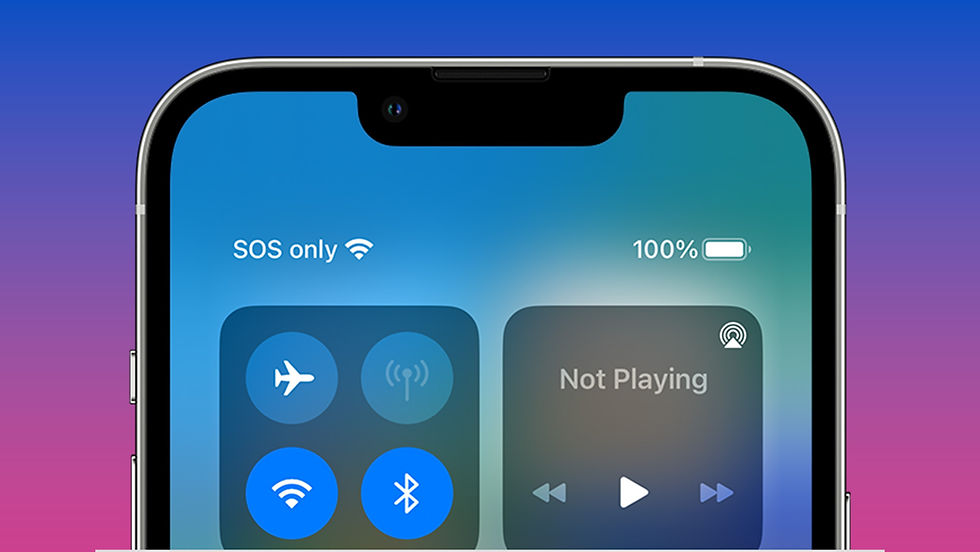What Does SOS Mean on iPhone? Explained for 2025
- Abhinand PS
.jpg/v1/fill/w_320,h_320/file.jpg)
- 5 days ago
- 3 min read
Introduction
If you’ve ever looked at your iPhone and noticed “SOS” or “SOS Only” instead of your usual cellular signal, you might wonder what it means and if there’s a problem. In 2025, this feature remains critical for your safety and connectivity, especially when regular cellular networks are unavailable. This guide will explain what SOS means on an iPhone, why it appears, how it works, and what you can do when you see it.

What Does SOS Mean on iPhone?
On an iPhone, SOS or SOS Only means your device has lost connection to your normal cellular network and cannot make regular calls, send texts, or use mobile data. However, it can still connect to any available cellular network for emergency calls. This emergency mode ensures you can always reach emergency services like 911 in the United States, 112 in Europe and India, or other local emergency numbers regardless of your carrier’s signal availability.
Why Does SOS Appear on Your iPhone?
The SOS mode appears when your iPhone cannot connect to your carrier’s network but detects a nearby network that supports emergency calls. Common reasons include:
Poor Network Coverage: Happens in remote areas, underground, or inside buildings with thick walls.
Carrier Outage: Temporary service disruptions from your mobile provider.
SIM Card Issues: SIM card problems like damage, improper insertion, or deactivation.
Traveling Internationally: Roaming is disabled or unavailable with the local carrier.
How Does SOS on iPhone Work?
Emergency Calls: Your iPhone bypasses regular carrier restrictions and connects to any available network to allow emergency calls.
Automatic Network Switching: It automatically switches to SOS mode when detecting lack of service from your primary carrier but finding alternative networks for emergencies.
Location Sharing: When you make an emergency call, your iPhone may automatically share your location with responders.
Emergency SOS via Satellite (on supported models): Newer iPhones (iPhone 14 and later) can connect directly to satellites to contact emergency services when there’s no cellular or Wi-Fi coverage.
What to Do When Your iPhone Shows SOS
Issue | Recommended Action |
Poor signal or remote area | Move to an area with better cellular coverage. |
Carrier outage | Wait for the carrier to restore services. |
SIM card problems | Remove, clean, and reinsert the SIM; replace if damaged. |
Roaming issues | Enable Data Roaming or buy a local SIM when abroad. |
Persistent SOS mode | Restart iPhone, update carrier settings, or reset network settings. |
Key Differences: SOS Mode vs. Emergency SOS vs. No Service
Feature | Description |
SOS / SOS Only | Limited network access; only emergency calls possible. |
Emergency SOS Feature | Manually trigger emergency call and alert contacts. |
No Service | No cellular network access at all, not even for emergency calls. |
Frequently Asked Questions (FAQs)
Can I make normal calls when SOS appears on iPhone?
No. When SOS or SOS Only is displayed, only emergency calls are possible.
Will SOS mode go away by itself?
SOS mode disappears once your iPhone reconnects to your carrier’s network.
How to fix iPhone stuck on SOS or Emergency SOS mode?
Try toggling Airplane mode, restarting your iPhone, checking SIM status, updating carrier settings, or resetting network settings. Contact your carrier if issues persist.
Conclusion
Seeing SOS on your iPhone is a safety feature ensuring you can always reach emergency services, even when regular cellular networks fail. Understanding this helps you stay calm, take appropriate action, and know how your iPhone prioritizes your safety in network-challenged situations. For more detailed iPhone tips and troubleshooting advice, visit abhinandps.com.



Comments